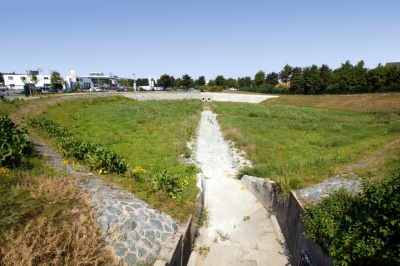Difference between revisions of "Reduce anthropogenic flow peaks"
(→General description) |
(→Applicability) |
||
| Line 10: | Line 10: | ||
==Applicability == | ==Applicability == | ||
| − | + | etention basins are dry between floods, fill and store water during floods, slowly drain when water levels in the receiving channel recede, and hence attenuate the runoff and reduce peak flows but have very limited effects on water quality. | |
| + | [[File:Stormwater retention basin.jpg|400px|thumbnail|dry stormwater detention basin in the Ruhr catchment, Germany (source: Bildarchiv Ruhrverband)]] | ||
| + | |||
| + | Retention basins have a permanent pool of water (like ponds) and, except for the runoff exceeding the capacity of the basin that drains to the channel, the water is stored permanently. Besides reducing peak flows, retention basin have a larger effect on water quality through sedimentation of pollutants and uptake of nutrients by plants. However, due to the water permanently stored, they have a lower capacity and hence, have to be larger. In contrast to infiltration basins, they are usually not explicitly built for groundwater recharge (in contrast to infiltration basins) but still may increase the risk of groundwater contamination (Fischer et al. 2003). | ||
| + | |||
| + | It is important to only reduce the peak flows and to ensure that low flows and environmental flows are maintained in receiving channels. | ||
==Expected effect of measure on (including literature citations): == | ==Expected effect of measure on (including literature citations): == | ||
Revision as of 12:02, 22 December 2015
Contents
- 1 General description
- 2 Applicability
- 3 Expected effect of measure on (including literature citations):
- 4 Temporal and spatial response
- 5 Pressures that can be addressed by this measure
- 6 Cost-efficiency
- 7 Case studies where this measure has been applied
- 8 Useful references
- 9 Other relevant information
General description
Water quantity and the flow regime can be altered by different factors such as changes in land cover, soil structure and compacting, loss of floodplains and wetlands, and stormwater runoff from urban areas. Loss of water retention combined with accelerated runoff typically increases the frequency and magnitude of flood peaks but also reduces the availability of water to streams during the prevailing low flow (base flow) periods.
Preferably, a more natural flow regime can be restored by increasing water infiltration and retention at the catchment scale by e.g. changes in land cover and floodplain restoration (see measure Improve water retention) since this addresses both, increased peak flows and reduced base flows. An alternative local end-of-pipe solution to reduce peak flows caused by stormwater runoff are retention and detention basins, which are of special importance for small rivers where single effluents may already cause massive erosion, affect water quality, and organisms are flushed away (catastrophic drift).
Please note:
- polders are not covered here but in the fact-sheet Link flood reduction with ecological restoration
- anthropogenic peak flows are also caused by hydropeaking; read more about measures to modify hydropeaking here
- this fact-sheet is equivalent with Reduce anthropogenic flow peaks
Applicability
etention basins are dry between floods, fill and store water during floods, slowly drain when water levels in the receiving channel recede, and hence attenuate the runoff and reduce peak flows but have very limited effects on water quality.
Retention basins have a permanent pool of water (like ponds) and, except for the runoff exceeding the capacity of the basin that drains to the channel, the water is stored permanently. Besides reducing peak flows, retention basin have a larger effect on water quality through sedimentation of pollutants and uptake of nutrients by plants. However, due to the water permanently stored, they have a lower capacity and hence, have to be larger. In contrast to infiltration basins, they are usually not explicitly built for groundwater recharge (in contrast to infiltration basins) but still may increase the risk of groundwater contamination (Fischer et al. 2003).
It is important to only reduce the peak flows and to ensure that low flows and environmental flows are maintained in receiving channels.
Expected effect of measure on (including literature citations):
- Decreased drift due to lower flow peaks,
- Increased chemical condition (less pollution) which has positive effects on stream biota.
Temporal and spatial response
Not available
Pressures that can be addressed by this measure
Cost-efficiency
Not available
Case studies where this measure has been applied
Useful references
- REFORM Wiki - Modify hydropeaking : http://wiki.reformrivers.eu/index.php/Modify_hydropeaking
- USGS - Runoff (surface water runoff) : http://water.usgs.gov/edu/runoff.html (accessed October 7th, 2015).
- MKULNV NRW (Ministerium für Klimaschutz, Umwelt, Landwirtschaft, Natur- und Verbraucherschutz des Landes Nordrhein-Westfalen): http://www.flussgebiete.nrw.de/index.php/Ma%C3%9Fnahmen/M1.0 (German)
